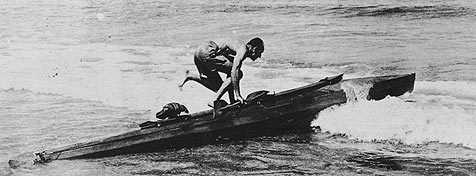This is Raroia in the Tuamotu Archipelago in French Polynesia where Thor Heyerdahl's now famous KON-TIKI raft made landfall on the 11th of August 1947, after having set out on the 28th of April from Peru to drift across the Pacific, as pre-Inca voyagers are believed to have drifted from South America to Polynesia.
As the 32-year-old ethnologist and adventurer reported at the time:
"This marks the conclusion - and, as such, the success - of our expedition. In the nearly fifteen weeks we have made the drift of more than 4,000 miles in the flow of the Peruvian (Humboldt) and South Equatorial Currents.
After three days of trying to get around long, low Raroia Reef, a spot in the French Tuamotu Islands at about Latitude 16.30 South and 144.3 West- we finally were drawn right in among the coral rocks. As there was no choice left to us, we directed the raft right into the roaring twenty-five-foot waves that broke in the area. All men were ordered to cling to the basic nine logs that form the body of the raft. When 600 yards from shore, we grounded on a low, half submerged mass of coral. Giant breakers came in and threw us onto other rocks, each a little closer to shore
The balsa-wood raft was taking an awful beating. Our hut was smashed to bits, and our hardwood mast was carried away. The steering oar went, and the cross logs from the stern and the bow. But the main logs held together, and we all clung to them, hoping for a chance to leap from them to some protruding coral and make our way along them to shore
Finally our chance came. We jumped onto some sharply pointed coral, along which we made our way 500 yards to shore. We are still there, on a tiny uninhabited island.
We have made several trips out to the marooned logs which constitute the remains of our raft, and have rescued most of our equipment. We also have our water and food supplies, and we are sleeping under the large Kin-Tiki sail- now stretched between two trees.
We will try to get the remaining logs into some quiet lagoon near here, and possibly we will be able to find some natives who can help us salvage the remains.
We are all in good condition and feel thankful that we have been able to save such things as food, water and an improvised radio."
As you read about the famous KON-TIKI expedition, remember that you won't have to build a balsa raft nor drift for more than three months across the South Pacific to get to luxurious SOHANO OCEAN VIEW APARTMENTS on tropical Sohano Island in Buka Passage.
